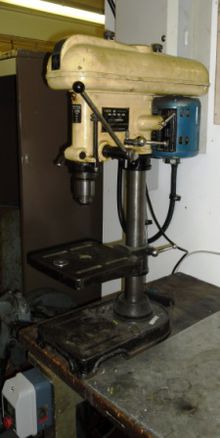Difference between revisions of "Fobco Bench Drill"
m |
|||
| Line 13: | Line 13: | ||
Classic British-made Bench drill for in the metalworking area. | Classic British-made Bench drill for in the metalworking area. | ||
| − | Chuck type and size. | + | ==Chuck type and size== |
| + | The drill is equipped with Jacobs Chuck. | ||
| − | Speeds. | + | ==Speeds== |
| + | Attached to the drill is a black plate that lists recommended speeds for different diameter drill bits. Generally speaking: Smaller drill bits require faster speeds, Larger bits require slower speed. | ||
| + | Changing the speed of the drill is fairly easy and can be done in less than 2 minutes. There is a black information plate on the side of the drill that shows the resulting speed from each belt configuration. | ||
| − | + | ===How to change the Speed=== | |
| + | {{#widget:YouTube|id=jGFlm40cNw0|width=385|height=640}} | ||
| − | Cleaning Up. | + | ==Lubrication, and coolant usage== |
| − | + | Using cutting paste whilst drilling metal is a good idea as it reduces the build up of heat, reduces chatter and can have a positive impact on tool life. You can find cutting paste on the benches at various points around the Metalworking Area. | |
| + | |||
| + | ==Cleaning Up== | ||
| + | Cleaning up swarf generated by drilling can be done using the dustpan and brush on the tool board behind the metalworking bench. | ||
| + | {{note|Swarf is sharp, Handle with care}} | ||
[[Category:Metalwork]] | [[Category:Metalwork]] | ||
Revision as of 22:51, 24 February 2019
| This page is a stub. You can help by expanding it! This page is included in the list of stub pages. (February 2019) |
| This page requires cleaning up! The specific problem is: TODO: What's It For, Usage, Safety, Maintenance Please help improve this page if you can. Use the talk page to discuss suggestions. (February 2019) |
| Fobco Bench Drill | |
|---|---|
| Manufacturer | Fobco |
| Location | Metalworking Area |
| Team | Metalworking |
| Induction Required | No |
| Tools: all pages • list • Power Tools • Broken tools {{}} | |
Classic British-made Bench drill for in the metalworking area.
Chuck type and size
The drill is equipped with Jacobs Chuck.
Speeds
Attached to the drill is a black plate that lists recommended speeds for different diameter drill bits. Generally speaking: Smaller drill bits require faster speeds, Larger bits require slower speed. Changing the speed of the drill is fairly easy and can be done in less than 2 minutes. There is a black information plate on the side of the drill that shows the resulting speed from each belt configuration.
How to change the Speed
Lubrication, and coolant usage
Using cutting paste whilst drilling metal is a good idea as it reduces the build up of heat, reduces chatter and can have a positive impact on tool life. You can find cutting paste on the benches at various points around the Metalworking Area.
Cleaning Up
Cleaning up swarf generated by drilling can be done using the dustpan and brush on the tool board behind the metalworking bench.
